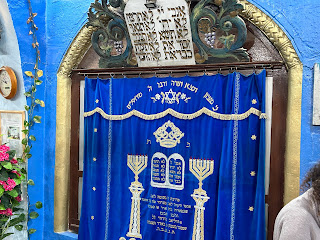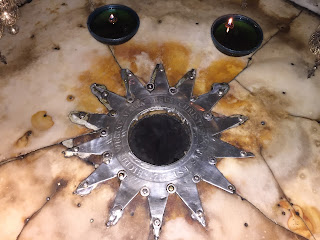Our recent family vacation has just concluded, albeit on a scary note. We had a medical emergency at the Luis Muñoz Marín International Airport in San Juan, PR. Linda’s and my oldest son Corey had a grand mal seizure in the waiting area near the gates. If you’ve known me on Facebook for the better part of the past 20 years, you may recall posts about Corey’s 2008 medical odyssey resulting in the removal of a cavernous hemangioma from his right temporal lobe (you can find those old posts if you wish). Then, seven years ago or so, he had a seizure at his lab bench and began what will be a lifetime of precautions and care in the hope of preventing future seizures.
However, despite lifestyle alterations and perpetual
medication, there is never a guarantee that he will not have another
seizure. And this was borne out for us last
Saturday morning at the San Juan airport. Corey’s family members were the first to attend to him, but other folks
around us also came to our aid – a woman from an Orlando seizure clinic and a
nurse practitioner, both of whom were (amazingly) sitting very close to
us. Eventually EMS arrived and treated
him in the short term until he could be loaded on a gurney and taken to the
hospital. I stayed in Puerto Rica with
Corey and Mika while Linda and others (including Eliza) flew home on our scheduled flight. We are all home now and Corey and Mika will
discuss next steps with his neurologist. And as a family we will support them in whatever comes next.
But from this point forward, this post is not about the medical side of the story, it's about how we were able to leverage modern technologies in 2024 in order to (1) remain connected with one another while separated by half a city in the short term and then, once their flight landed in Wilmington, by nearly 1,600 miles; (2) address the challenges of communicating with ER staff who mostly did not speak English; and (3) navigate a distant and unknown city in the midst of the stressful tumult of this ordeal.
Here are some of the challenges we faced, how we addressed them with technology, and how it might have looked 40 years earlier, before the era of the smart phone or even the rudimentary cell phone.
· EMS told us the name of the hospital, but I was unsure of where it was or if it was the only hospital by that name in that large city. In the turmoil of the moment, I didn’t think to ask. But in 2024, I was able to use the web browser on my iPhone to answer both those questions. In 1984, I would have needed to find an English speaker at an airport information desk and then take that information on faith.
· Since the ambulance could only accommodate one other person, I had to get to the hospital on my own. I used my Uber app to quickly find a ride to the hospital. In 1984, I would have needed to hail a cab, admittedly not a huge hurdle.
·
Once I got to the ER, I was able to freely call
and text Linda on her iPhone while she was still on the ground at the airport. In 1984, there would have been no texting and
calling would have been very impractical as it would have required us both to
use pay phones. Since we are beyond even a vestigial presence of pay phones in most public spaces, it is hard to know how hard this would've been; there would've needed to be a pay phone near the airport gate and one near Corey's exam room in the ER for this to have been even remotely practicable.
· Eventually the others boarded their flight and left. In 1984, this would have meant nearly four hours of uncertainty with no communication. And I would have no way of knowing when they had landed. In the present, although I still couldn't communicate with them midflight, at least I could track their flight using the Flight Aware app. I could see them make progress out over the Atlantic Ocean and I could see when they were safely on the ground in Wilmington so we could reopen communication by text and phone.
· Linda and the others flew home with all the luggage, including Corey’s, Mika’s, and mine. But it wouldn’t all fit in our car at the airport along with Linda, Emlyn, Rachel, Dylan, and Eliza. Mika’s Subaru was also at the airport, but the car keys were with us in PR. I was able to talk to Emlyn on the phone so he could tell me when they were standing next to Mika’s car. Corey was able to remotely unlock and lock the car from his phone in the ER in San Juan using the Subaru app. This allowed Emlyn to securely stow our bags in the car at the Wilmington airport. In 1984, arrangements would have needed to be made for (1) storing the luggage at the airport or (2) finding a cab as a second vehicle in order to accommodate all the people and luggage.
· Most of the ER staff spoke very little English. I was able to do rudimentary things like greet people, say thank you, and ask the location of the bathroom, but I relied on Google Translate to communicate with them on the important matters related to Corey’s care. In 1984, we would have had to do our best to work through the language barrier and hope for the best.
· Our plan was to get Corey treated and released, make our way to the airport, and find a flight home. I was able to use my Kayak app while we waited in the ER to monitor available flights home (and I watched them sell out, one after the other, on one of the busiest travel weekends of the year...). If not for the uncertainty of how long we would be in the ER, I could have also booked one from the hospital. When we finally did leave the hospital, we were able to use Kayak to give us a sense of what airline to try first, so we knew where to have our Uber driver drop us off (it is a large international airport with several terminals). In 1984, we would have had no idea of potential flights and would have needed to move from airline counter to airline counter in trial-and-error fashion in an attempt to find a flight.
· Once we found a flight, I was able to communicate this to everyone at home by text and was able to call with updates about how Corey was doing and how Mika and I were holding up. In 1984, this would have required a pay phone and unless I was able to give Linda the number of a pay phone in the airport and we sat near that phone, it would have meant calls would have occurred only when I initiated them.
· Once we touched down in Philadelphia the next morning, I was able to text Emlyn about what terminal he should come to in order to collect us and take us home.
As I said, Corey and Mika are not in this alone. We will navigate this next chapter as a family by supporting them as they need it, and I'm confident we will continue to leverage 2024 technologies in order to do so.
Until next time…
















































